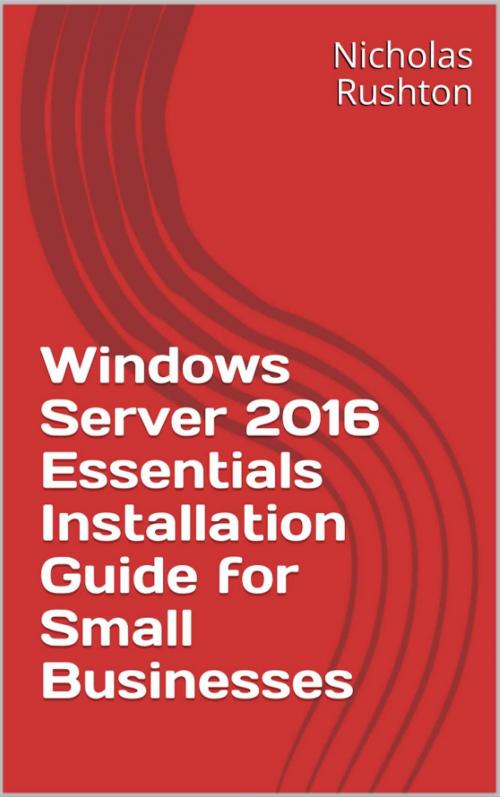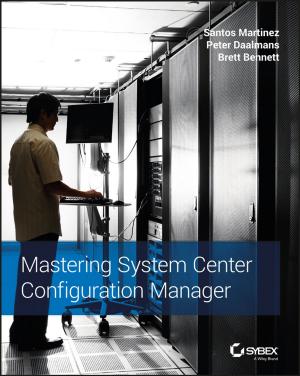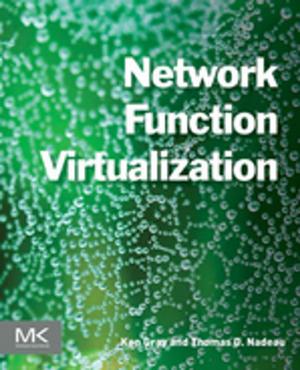Windows Server 2016 Essentials Installation Guide for Small Businesses
Nonfiction, Computers, Networking & Communications| Author: | Nicholas Rushton | ISBN: | 1230001413007 |
| Publisher: | CTACS | Publication: | November 22, 2018 |
| Imprint: | Language: | English |
| Author: | Nicholas Rushton |
| ISBN: | 1230001413007 |
| Publisher: | CTACS |
| Publication: | November 22, 2018 |
| Imprint: | |
| Language: | English |
The "Missing Guide". Second Edition. Updated November 2018.
Windows Server 2016 Essentials is the popular version of Microsoft's server operating system designed for organizations with up to 25 employees. However, as with most modern applications it comes with only the most basic of instructions. Windows Server 2016 Essentials Installation Guide for Small Businesses is a succinct installation guide produced from a real world perspective and written according to the Goldilocks Principle - not too little information, not too much information, but just right. With over 190 illustrations and screenshots, practical examples and clear explanations it takes you through setting up Essentials in a typical small business. Whether you are installing Essentials for the first time, are planning to do so or are just plain curious, you will find this proven guide of interest and help.
- HARDWARE AND INFRASTRUCTURE
1.1 What is Windows Server Essentials 2016?
1.2 A Typical Small Network
1.3 The Server
1.4 Disk Drives and Storage Options
1.5 Switch and Wireless Access Points
1.6 Client Devices
1.7 IP Considerations - INSTALLATION OF WINDOWS SERVER 2016 ESSENTIALS
2.1 Overview
2.2 Installing Essentials
2.3 Windows Server Essentials User Interface - USERS AND FOLDERS
3.1 Overview
3.2 Setting up Storage Spaces
3.3 Creating User Accounts
3.4 Managing Users
3.5 Folder Redirection
3.6 Relocating the Built-in Server Folders
3.7 Creating Additional Folders
3.8 User Groups - CONNECTING COMPUTERS TO THE SERVER
4.1 Overview
4.2 Using the Windows Server Essentials Connector
4.3 Additional Considerations When Connecting Windows 8 Clients
4.4 Troubleshooting the Windows Server Essentials Connector
4.5 Disabling the Launchpad
4.6 Adding a Computer to the Domain without using the Connector
4.7 Connecting Computers with Home Editions of Windows
4.8 Connecting Macs
4.9 Connecting Linux Computers
4.10 Removing a Computer from the Network - BACKUPS AND RESTORES
5.1 Overview
5.2 Configuring Backups for the Server
5.3 Restoring Files to the Server
5.4 Backing up to a Network Drive
5.5 Configuring Backups for the Computers
5.6 Restoring Data to a Computer
5.7 Client Restore Service - PRINTING
6.1 Overview
6.2 Networked Printer
6.3 Shared Printer via Server - REMOTE ACCESS
7.1 Overview
7.2 Setting up Anywhere Access
7.3 Controlling Anywhere Access for Individual Users
7.4 Using Remote Web Access
7.5 Customizing the Logon Page
7.6 Using the VPN (Virtual Private Network)
7.7 Using Dropbox with Essentials - WORKING WITH MOBILE DEVICES
8.1 Overview
8.2 Accessing the File System with File Browser
8.3 Using Dropbox
8.4 My Server App for Windows Phone
8.5 Microsoft Remote Desktop app for iOS
8.6 Chromebooks - HOUSEKEEPING AND MONITORING THE HEALTH OF THE SYSTEM
9.1 Overview
9.2 Windows Defender
9.3 Third Party Antimalware/Antivirus Software
9.4 Checking the Dashboard
9.5 Generating a Report
9.6 Customizing the Health Report
9.7 Setting up a Scheduled Health Report
9.8 Optimizing the Hard Drives
9.9 Applying Windows Updates to the Server
9.10 Shutting Down & Restarting the Server
9.11 Task Manager and Resource Monitor - GROUP POLICY
10.1 Overview
10.2 Group Policy Management Console
10.3 Specifying the Home Page
10.4 Windows Logon Behaviour
10.5 Logon Warning/Security Message - OFFICE 365
11.1 Overview
11.2 Installation
11.3 Creating a New User
11.4 Assigning an Existing Local Account
11.5 Removing and Blocking an Online Account
11.6 Checking Who Has an Online Account
11.7 Changes to Storage Page in Dashboard
11.8 Changes to Devices Page in Dashboard - MISCELLANEOUS & ADVANCED TOPICS
12.1 Overview
12.2 Windows Activation
12.3 Ease of Access
12.4 Server Manager
12.5 Accessing the Internet from the Server
12.6 Restore Missing Shortcut to Shared Folders
12.7 Drive Mappings via Login Script
12.8 Controlling User Logon Times
12.9 Using Remote Desktop to Manage the Server
12.10 Using Remote Desktop to Manage Computers
12.11 Add-ins
12.12 Installing DHCP
12.13 Multiple Network Adapters (NIC Teaming)
12.14 Windows Firewall
12.15 Installing Windows Server Essentials Experience on Server 2016
The "Missing Guide". Second Edition. Updated November 2018.
Windows Server 2016 Essentials is the popular version of Microsoft's server operating system designed for organizations with up to 25 employees. However, as with most modern applications it comes with only the most basic of instructions. Windows Server 2016 Essentials Installation Guide for Small Businesses is a succinct installation guide produced from a real world perspective and written according to the Goldilocks Principle - not too little information, not too much information, but just right. With over 190 illustrations and screenshots, practical examples and clear explanations it takes you through setting up Essentials in a typical small business. Whether you are installing Essentials for the first time, are planning to do so or are just plain curious, you will find this proven guide of interest and help.
- HARDWARE AND INFRASTRUCTURE
1.1 What is Windows Server Essentials 2016?
1.2 A Typical Small Network
1.3 The Server
1.4 Disk Drives and Storage Options
1.5 Switch and Wireless Access Points
1.6 Client Devices
1.7 IP Considerations - INSTALLATION OF WINDOWS SERVER 2016 ESSENTIALS
2.1 Overview
2.2 Installing Essentials
2.3 Windows Server Essentials User Interface - USERS AND FOLDERS
3.1 Overview
3.2 Setting up Storage Spaces
3.3 Creating User Accounts
3.4 Managing Users
3.5 Folder Redirection
3.6 Relocating the Built-in Server Folders
3.7 Creating Additional Folders
3.8 User Groups - CONNECTING COMPUTERS TO THE SERVER
4.1 Overview
4.2 Using the Windows Server Essentials Connector
4.3 Additional Considerations When Connecting Windows 8 Clients
4.4 Troubleshooting the Windows Server Essentials Connector
4.5 Disabling the Launchpad
4.6 Adding a Computer to the Domain without using the Connector
4.7 Connecting Computers with Home Editions of Windows
4.8 Connecting Macs
4.9 Connecting Linux Computers
4.10 Removing a Computer from the Network - BACKUPS AND RESTORES
5.1 Overview
5.2 Configuring Backups for the Server
5.3 Restoring Files to the Server
5.4 Backing up to a Network Drive
5.5 Configuring Backups for the Computers
5.6 Restoring Data to a Computer
5.7 Client Restore Service - PRINTING
6.1 Overview
6.2 Networked Printer
6.3 Shared Printer via Server - REMOTE ACCESS
7.1 Overview
7.2 Setting up Anywhere Access
7.3 Controlling Anywhere Access for Individual Users
7.4 Using Remote Web Access
7.5 Customizing the Logon Page
7.6 Using the VPN (Virtual Private Network)
7.7 Using Dropbox with Essentials - WORKING WITH MOBILE DEVICES
8.1 Overview
8.2 Accessing the File System with File Browser
8.3 Using Dropbox
8.4 My Server App for Windows Phone
8.5 Microsoft Remote Desktop app for iOS
8.6 Chromebooks - HOUSEKEEPING AND MONITORING THE HEALTH OF THE SYSTEM
9.1 Overview
9.2 Windows Defender
9.3 Third Party Antimalware/Antivirus Software
9.4 Checking the Dashboard
9.5 Generating a Report
9.6 Customizing the Health Report
9.7 Setting up a Scheduled Health Report
9.8 Optimizing the Hard Drives
9.9 Applying Windows Updates to the Server
9.10 Shutting Down & Restarting the Server
9.11 Task Manager and Resource Monitor - GROUP POLICY
10.1 Overview
10.2 Group Policy Management Console
10.3 Specifying the Home Page
10.4 Windows Logon Behaviour
10.5 Logon Warning/Security Message - OFFICE 365
11.1 Overview
11.2 Installation
11.3 Creating a New User
11.4 Assigning an Existing Local Account
11.5 Removing and Blocking an Online Account
11.6 Checking Who Has an Online Account
11.7 Changes to Storage Page in Dashboard
11.8 Changes to Devices Page in Dashboard - MISCELLANEOUS & ADVANCED TOPICS
12.1 Overview
12.2 Windows Activation
12.3 Ease of Access
12.4 Server Manager
12.5 Accessing the Internet from the Server
12.6 Restore Missing Shortcut to Shared Folders
12.7 Drive Mappings via Login Script
12.8 Controlling User Logon Times
12.9 Using Remote Desktop to Manage the Server
12.10 Using Remote Desktop to Manage Computers
12.11 Add-ins
12.12 Installing DHCP
12.13 Multiple Network Adapters (NIC Teaming)
12.14 Windows Firewall
12.15 Installing Windows Server Essentials Experience on Server 2016















